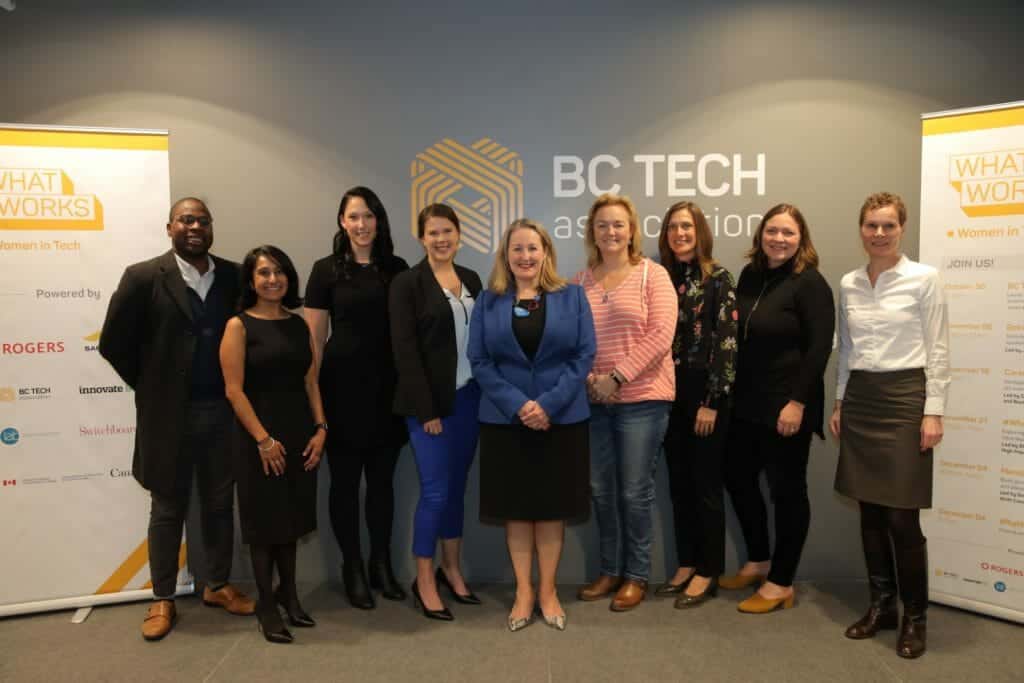
04 Dec 2019 BC Tech’s #WhatWorks Series shares Strategies for Tech Success among Women
Enthusiastic response prompts three-month extension
VANCOUVER, BC, December 5, 2019 — Over the course of the last eight weeks, the BC Tech Association’s #WhatWorks: Women in Tech Series has made great strides in moving the dial on diversity and inclusion by equipping hundreds of women with strategies for shaping successful tech careers. In fact, the response to the series has been so remarkable that #WhatWorks has been extended through March.
“We are thrilled that #WhatWorks: Women in Tech is exceeding expectations, and are deeply grateful to everyone involved,” said BC Tech Association CEO Jill Tipping, who took a lead role in guiding the series. “We launched #WhatWorks because women make up only 18 percent of the tech workforce here in B.C. We must, and we will, do better, and this starts with sharing success stories and strategies that lead the way for the wider community. With women comprising just 17 percent of our own board, it also starts with a commitment from BC Tech: We will double the number of women on our board within the next 12 months.”
Those announcements weren’t the only highlights of the #WhatWorks year-end reception, which took place on December 4th at the BC Tech Hub. Gleaned from participants and leaders alike over the course of the series, BC Tech unveiled 15 practical, actionable strategies for unlocking the tech sector’s full potential by boosting the participation of women across five key areas:
1. Data
- Set targets and publish the results. Ask if your employee diversity mirrors that of your customers.
- Take a hard look at your data through an intersectional lens: promotion, retention, starting salaries, out-of-cycle compensation increases. Put in place policies to support an even playing field.
- Use available tools to ensure your job descriptions don’t use gendered language. (eg. http://gender-decoder.katmatfield.com/)
2. Recruitment
- Establish dedicated internship and new hire programs to broaden your scope right at the start.
- Leverage your team’s network by asking women in your organization to identify people they’ve worked with in the past and would like to work with again.
- Fill your hiring pipeline with as diverse a candidate pool as possible, and insist that hiring managers work from shortlists that are 50/50 gender-balanced. Don’t accept all-male rosters from recruiters.
3. Culture
- Be clear and fact-based about the plans being put in place to address diversity and inclusion. Don’t apologize, over-explain or otherwise ask for permission for the change.
- Find your internal allies. Be an internal ally by speaking up.
- Educate the team on unconscious bias, provide respectful workplace training, and put in place mechanisms that enable people to speak up.
4. Career Development
- Take a proactive approach to career development. This has benefits for all, but making it the norm will ensure everyone participates even if they aren’t comfortable asking.
- Ask yourself if the talent is promotable before someone takes parental leave, and consider promoting before they take leave.
- Put in place skills-building workshops to address areas under-represented groups sometimes find challenging, such as negotiation, effective presentation skills, and managing your manager.
5. Pay Equity
- Proactively and regularly review job titles, scope and complexity of work and compensation to be sure compensation is in line with the duties performed. Don’t assume promotions happen automatically when duties expand.
- Put in place salary bands for each role, track and communicate pay vs. industry averages (compare ratios). Establish and enforce minimum salaries for each role.
- Don’t try to tackle inequity that has built up over years through the annual process. You may need to be prepared to have a one-time budget to address the issue.
“The strategies unveiled at the #WhatWorks year-end reception are a testament to our engaged and enthusiastic series participants, and to the expertise and commitment of our workshop and panel leaders,” Tipping said. The latter included BC Galvanize CEO Laurie Schultz, Allocadia CEO Kristine Steuart, interim Science World CEO Janet Wood, Seaspan ULC’s David Hargreaves, Dynamic Shift Consulting president Sean Bacon, SAP Canada’s Heike Neumann, STEMCELL Technologies’ Helen Sheridan, Amanda Mallow of Sophos, Beanworks Solutions CEO Catherine Dahl, Work at Play partner Ani Phelan, and East Side Games’ Lidi Giroux.
Series sponsors Innovate BC and Rogers Communications also expressed enthusiasm for the series. “As we represent the government of British Columbia and the people who make up the innovation ecosystem in the province, Innovate BC is proud to be involved in this initiative,” said Raghwa Gopal, President & CEO of Innovate BC. “Finding ways to make the province’s tech sector stronger is integral to our mission, and boosting the number of women in the sector will do exactly that.”
Reception attendance was by donation to benefit Actua, a national charity that creates life-changing science and technology experiences for kids, and was facilitated by Vancouver-based Charitable Impact.
About BC Tech
BC Tech is a non-profit dedicated to making British Columbia the best place to grow and scale a tech company. We pursue this mission by providing the places and events for the community to come together; impactful programs that help companies grow, scale, export and adopt technologies; up to date information about the tech sector; and the solutions required to ensure our industry and our Province continue to grow and thrive. To learn more, visit www.wearebctech.com
Additional media assets, including photos and video from the event, logos of sponsors, series logos, the publication, and a media backgrounder on the series can be found here.
Media Contact:
Kathleen Reid
T: 604-724-1242
E: media@wearebctech.com

